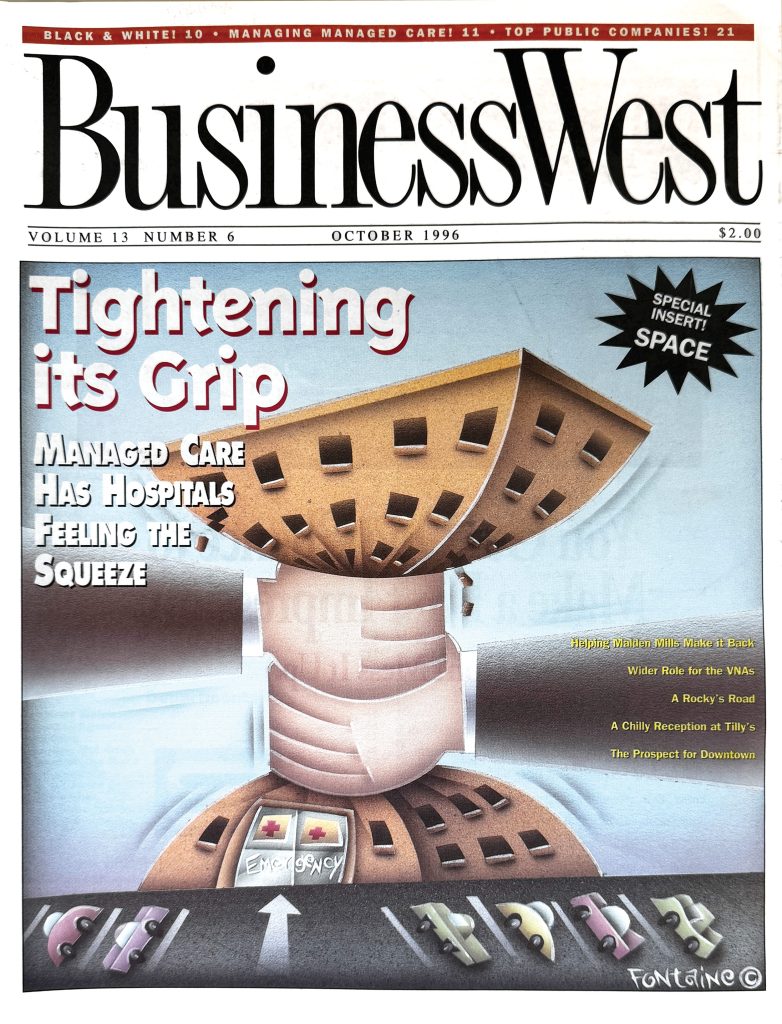
40 Years of Healthcare
Hospitals Grapple with Some Significant Trends
 Twenty years ago, in the issue commemorating BusinessWest’s 20th anniversary, area hospital leaders talked about what had changed the most over two decades, and they all mentioned the same thing: a shortening of hospital stays, with procedures that once required a several-night stayover now requiring only one — or none at all.
Twenty years ago, in the issue commemorating BusinessWest’s 20th anniversary, area hospital leaders talked about what had changed the most over two decades, and they all mentioned the same thing: a shortening of hospital stays, with procedures that once required a several-night stayover now requiring only one — or none at all.
Today’s hospital leaders are still talking about it — because the trend has only accelerated.
“The time people spend inside the hospital for various procedures has been shortened significantly,” Holyoke Medical Center Spiros Hatiras said. “When I started in healthcare 30 years ago, someone would come in for a gallbladder surgery and spend four days in the hospital. Now it’s the same day, come in and leave.
“The same with other procedures,” he went on. “People even get knee replacements and leave the same day. For bariatric surgery, they just stay one night. They used to spend more time in the hospital, so that definitely has changed.”
Dr. Mark Keroack, president of Baystate Health, noted that, around the time BusinessWest ran that story, he started seeing an accelerating shift to more procedures done in the outpatient arena — which has impacted revenues across virtually all hospitals.
“We have 1,000 hospital beds, but 60% of our revenue comes from the ambulatory side. And even in my career, things that used to land you in the hospital for a week don’t anymore. Now you’re out in a day. That is an incredible advance because of microsurgery and advanced techniques.”
The other dramatic shift regionally — and nationally — has been a trend toward consolidation. Over the past four decades, Baystate Health, and its flagship hospital, Baystate Medical Center, have brought formerly independent hospitals in Greenfield, Palmer, and Westfield under its umbrella, while Mercy Medical Center was acquired by Trinity Health, and Cooley Dickinson Hospital is now part of the Mass General Brigham family.
“Healthcare has been evolving, and how hospitals are reimbursed has become extraordinarily challenging. There’s been a shift from inpatient care to outpatient care, which is beneficial for the community, but challenging to maintain revenues to support hospitals, which communities rely on for services,” said Dr. Robert Roose, president of both Mercy and Johnson Memorial Hospital in Enfield, Conn., both part of the Trinity family.
“And as those trends continue to shift and reimbursement rates for services decrease, that has reinforced the value of being part of a large system that has scale, that can leverage strengths across the service area.”
Cooley Dickinson Health Care President Dr. Lynnette Watkins said Cooley becoming part of Mass General Brigham just over a decade ago has been a benefit in many ways, and a model for what’s happening with formerly independent hospitals across the country.
Dr. Mark Keroack
“We have 1,000 hospital beds, but 60% of our revenue comes from the ambulatory side. And even in my career, things that used to land you in the hospital for a week don’t anymore. Now you’re out in a day.”
“So you still have that community impact, but you’re also backed by a larger network,” she told BusinessWest, citing, as one example, a current, $26 million capital project that will add about 7,700 square feet to the Emergency Department, increasing its footprint by about 40%. “We would not be able to undertake a renovation like this without the support of Mass General Brigham and its ability to engage and identify contractors and work through supply-chain issues and, candidly, to finance a project as large as this.
“Also, in order to be able to recruit and retain talent, particularly in primary care, we have to be competitive in the market,” Watkins continued. “And a lot of our colleagues come to Cooley Dickinson for that great community feel and care, but also are attracted by competitive compensation and the fact that we’re part of Mass General Brigham.”
Baystate’s own growth story began almost 50 years ago with the merger of three facilities into what is now known as Baystate Medical Center — and it has grown significantly since, with the expansion of Baystate Children’s Hospital, a massive addition known as the Hospital of the Future in 2012, and other projects.
But Baystate Health also encompasses Baystate Franklin Medical Center in Greenfield, Baystate Noble Hospital in Westfield, and Baystate Wing Hospital in Palmer, along with a host of physician practices and a cluster of specialty services in Springfield’s North End, most notably the D’Amour Center for Cancer Care, which opened in 2004.
“People don’t have to leave the area to get their care, and to get advanced medical care — level-1 trauma, neonatal ICU, specialty cancer care, specialty pediatric care, all those things that built up over the years,” said Keroack, who will retire from a more than four-decade career in healthcare this year. “Baystate has grown to the point where we’re doing roughly 65% of the medical care in Western Mass.”
Dr. Lynnette Watkins
“During COVID, we lost hospital personnel because they got sick or their families got sick or burnout occurred and individuals decided to take time off. We also had trainees in the pipeline that, for a couple of years, did not have the ability to learn at the bedside.”
At the same time, he added, a number of small hospitals closed or were repurposed over the years, from Ludlow Hospital to Farren Memorial Hospital in Turners Falls to Mary Lane Hospital in Ware, partly because of that shift to outpatient care and the ability of the region’s larger hospitals to diversify what they offer. “It’s hard for a small community hospital to make it.”
Getting Back to Work
That said, all hospitals these days, of all sizes, are struggling with workforce shortages across the spectrum, from nurses to many specialists.
Keroack said Baystate employs around 13,500 people and, before the pandemic, typically averaged 600 to 700 open positions at any given time. That number shot up to 2,100 during the Omicron phase of COVID — a time known in healthcare as the Great Resignation.
“No one wanted to work in healthcare. It was scary and difficult,” he recalled. “But we’ve done an awful lot to be better employers — we’ve done a lot with workplace safety, flex schedules, employee wellness, and novel approaches to new pipelines with our education and training partners.”
With almost 1,500 openings currently, “we’re about halfway back to where we used to be,” he added. “There’s still some work to do, but we’re making good progress and heading in the right direction.”
Watkins agreed that COVID took a toll on the workforce at Cooley Dickinson.
“We’ve had shortages before, particularly in nursing, but in the technical fields as well — radiology technologists, pharmacy techs, laboratory techs — but during COVID, we lost hospital personnel because they got sick or their families got sick or burnout occurred and individuals decided to take time off.
Spiros Hatiras
“Even though you have interoperability, the systems are not talking to each other. It’s a mess, if you ask me, where you could have made a really big breakthrough in medical records.”
“We also had trainees in the pipeline that, for a couple of years, did not have the ability to learn at the bedside,” she added. “And learning on the screen or in a sim lab is not the same as learning at the bedside. So these graduates are taking longer to complete their training, and taking longer to onboard and orient. That means more folks, particularly those that enjoy teaching and mentoring, are really required in order to bring this new cohort along.”
That has ramped up partnerships with UMass Amherst, Bay Path University, Springfield Technical Community College, and others on targeted programs to get more talent into the pipeline, from certified nurse aides to lab techs and surgical techs.
“One of the silver linings is that it has really forced us to be creative and collaborative,” Watkins said. “We even have high-school and college students as a part of our volunteer programs here at the hospital, so that young people can get exposed to what it means to be in a hospital, and what sorts of positions there are. Doctors and nurses are important, but there are other ways that you can work in the hospital and have a great experience.”
Roose said healthcare leaders have come to understand the importance of caregivers’ concerns at a time when the industry in general is at “an inflection point” when it comes to how hospitals operate.
“We need to double down and maximize our efforts to support caregivers through systems that keep people well and transform the systems that keep people well and transform our services in ways that meet the evolving needs not only of the patients we serve, but the colleagues that are part of our mission and drive service.”
Holyoke Medical Center has taken big steps to address those concerns as well, Hatiras said, including with compensation, but the system has still struggled, emerging from the pandemic, with employee expectations when it comes to long hours, weekends, and on-call hours — and a desire for more of their work to be remote, which isn’t always possible.
That said, artificial intelligence could begin to have a broader role, not in replacing providers, but making their jobs a little easier.
“You can have a natural conversation with the patient about their condition; the doctor can tell you what your blood pressure is, the patient can say what their symptoms are, and you can have AI listening in and creating an actual note for the chart instead of someone having to transcribe it or dictate it or type it,” Hatiras said, adding that AI can process copious amounts of information and … not make a diagnosis, exactly, but augment the doctor’s own decision making.
“It could be helpful as an overlay with all the patients that come and go — ‘hey, doctor, can you check this patient based on the data input? He may need attention; he may have sepsis; he may have an infection.’ It can be a tool to assist.”
Evolution Continues
Speaking of technology, Hatiras noted that one of the most monumental changes in healthcare in recent decades is the electronic medical record.
“I would say there are benefits and drawbacks. One benefit is that you can access certain information from anywhere. In the old days, you had paper charts, and if a doctor was on call and needed to look at somebody’s chart, he couldn’t. Now you can look at it — X-rays, lab results, all sorts of things. And there’s certainly more data being captured this way.”
The main downside is what Hatiras characterizes as a big missed opportunity, and that’s the failure of the U.S. government, early on, to establish a bid process and choose the best electronic medical record system and make it the national standard.
“What has happened is we have a hodgepodge of a system,” he explained. “If you physically cover more than one hospital, it’s a bear; you’ve got to learn each other’s systems: how to input orders, how to check labs. It’s not easy. Secondly, you can’t train for it in medical school because what system are you going to train on? If we had a national system, we could be learning this from year one in medical school. And even though you have interoperability, the systems are not talking to each other. It’s a mess, if you ask me, where you could have made a really big breakthrough in medical records.”
Speaking of government, Keroack noted that the way healthcare is paid for has changed dramatically, especially over the two decades since Romneycare; today, 97% of Massachusetts residents carry health insurance.
And with more than 90% of Baystate patients cared for under a global budget — specifically, Medicare and Medicaid accountable-care organizations — “if we overspend or are inefficient, we have to eat the difference. It leads us to emphasize prevention, wellness, and coordination of care. It’s changed the way doctors think about keeping people healthy.”
Today, with an older population than the national average, 70% of Baystate’s payments come from Medicaid and Medicare and 30% from commercial managed care, while the average hospital in the U.S. is 40% government and 60% managed care.
“Over time, the country’s going to have to tackle the question of whether we move to some single-payer health approach,” Keroack added. “We’re not done as a nation dealing with the cost of healthcare. We have the highest cost of healthcare in the world and the most splintered, uncoordinated program of paying for it.”
Meanwhile, major projects continue locally in an effort to meet community needs, from Cooley Dickinson’s Emergency Department overhaul — the ER was built in the 1970s when ER visits were less than half what they are today — to Trinity Health’s Enfield Ambulatory Center, which will reflect that overall shift toward outpatient care.
“There will continue to be an emphasis on innovation, technology, and what will be known as precision medicine or personalized medicine as we move into the future,” Roose said, citing projects at Mercy from a new palliative-care center to an agreement with the US Oncology Network to improve services, technology, and access to clinical trials.
“The main emphasis will continue to be on compassionate care and creating experiences that are holistic and compassionate and help people along their healing journey.”








